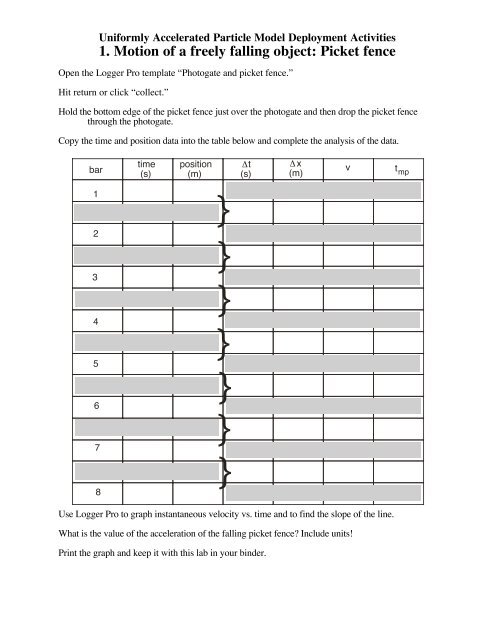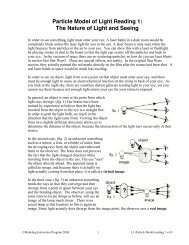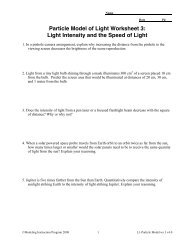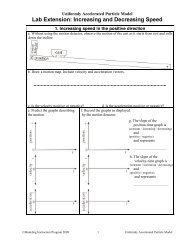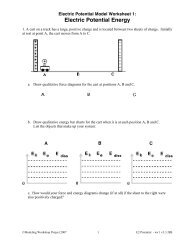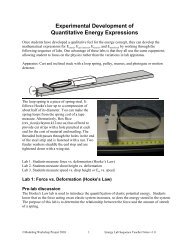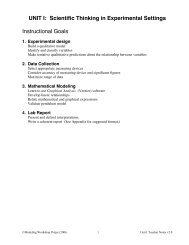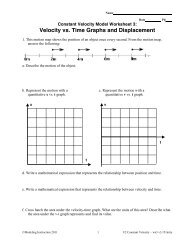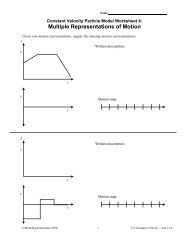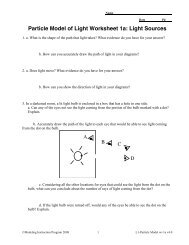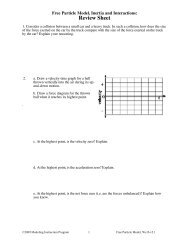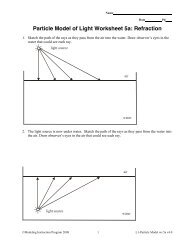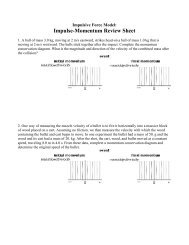Freefall and top of the flight; Fan cart motion
Freefall and top of the flight; Fan cart motion
Freefall and top of the flight; Fan cart motion
You also want an ePaper? Increase the reach of your titles
YUMPU automatically turns print PDFs into web optimized ePapers that Google loves.
Uniformly Accelerated Particle Model Deployment Activities<br />
1. Motion <strong>of</strong> a freely falling object: Picket fence<br />
Open <strong>the</strong> Logger Pro template “Photogate <strong>and</strong> picket fence.”<br />
Hit return or click “collect.”<br />
Hold <strong>the</strong> bottom edge <strong>of</strong> <strong>the</strong> picket fence just over <strong>the</strong> photogate <strong>and</strong> <strong>the</strong>n drop <strong>the</strong> picket fence<br />
through <strong>the</strong> photogate.<br />
Copy <strong>the</strong> time <strong>and</strong> position data into <strong>the</strong> table below <strong>and</strong> complete <strong>the</strong> analysis <strong>of</strong> <strong>the</strong> data.<br />
bar<br />
time<br />
(s)<br />
position<br />
(m)<br />
Δt<br />
(s)<br />
Δ x<br />
(m)<br />
v<br />
t mp<br />
1<br />
2<br />
3<br />
4<br />
5<br />
6<br />
7<br />
8<br />
}<br />
}<br />
}<br />
}<br />
}<br />
}<br />
}<br />
Use Logger Pro to graph instantaneous velocity vs. time <strong>and</strong> to find <strong>the</strong> slope <strong>of</strong> <strong>the</strong> line.<br />
What is <strong>the</strong> value <strong>of</strong> <strong>the</strong> acceleration <strong>of</strong> <strong>the</strong> falling picket fence Include units!<br />
Print <strong>the</strong> graph <strong>and</strong> keep it with this lab in your binder.
2. Motion <strong>of</strong> a freely falling object: Basketball<br />
The <strong>motion</strong> detector is on <strong>the</strong> floor, wedged between two bricks to protect it.<br />
Practice throwing <strong>the</strong> ball straight up over <strong>the</strong> detector. Be careful to keep your h<strong>and</strong>s out <strong>of</strong> <strong>the</strong><br />
way.<br />
Predict what <strong>the</strong> graphs will look like describing <strong>the</strong> up <strong>and</strong> down <strong>motion</strong> <strong>of</strong> <strong>the</strong> ball on <strong>the</strong> graph<br />
axes below.<br />
+<br />
x<br />
Predictions<br />
Observations<br />
+<br />
x<br />
0<br />
+<br />
t<br />
0<br />
+<br />
t<br />
v<br />
v<br />
0<br />
t<br />
0<br />
t<br />
-<br />
-<br />
+<br />
a<br />
+<br />
a<br />
0<br />
t<br />
0<br />
t<br />
-<br />
-<br />
Open <strong>the</strong> Logger pro template “Basketball <strong>and</strong> <strong>motion</strong> detector.”<br />
Hit return or click “collect.”<br />
Once you get a good throw, record your observations on <strong>the</strong> right set <strong>of</strong> graph axes above.<br />
Record <strong>the</strong> value <strong>of</strong> <strong>the</strong> acceleration <strong>of</strong> <strong>the</strong> basketball from <strong>the</strong> graph: ________________<br />
Include units!<br />
Fill in <strong>the</strong> following table with algebraic signs <strong>of</strong> +, -, or zero.<br />
going up at <strong>the</strong> <strong>top</strong> coming down<br />
position:<br />
velocity:<br />
acceleration:
3. Motion <strong>of</strong> a fan <strong>cart</strong>: Away, <strong>the</strong>n Back<br />
a. Turn on <strong>the</strong> fan <strong>and</strong> observe <strong>the</strong> <strong>motion</strong> <strong>of</strong> <strong>the</strong> <strong>cart</strong> after an initial push without using <strong>the</strong> <strong>motion</strong><br />
detector. Answer <strong>the</strong> following questions for <strong>the</strong> <strong>cart</strong> while coasting.<br />
<strong>motion</strong><br />
detector<br />
air flow<br />
Give <strong>the</strong> <strong>cart</strong> an initial push to <strong>the</strong> right.<br />
S<strong>top</strong> it before it reaches <strong>the</strong> detector on <strong>the</strong> way back.<br />
b. Draw a <strong>motion</strong> map including both velocity <strong>and</strong> acceleration vectors.<br />
c. Is <strong>the</strong> velocity positive or negative d. Is <strong>the</strong> acceleration positive or negative<br />
Does <strong>the</strong> direction <strong>of</strong> <strong>the</strong> velocity change Does <strong>the</strong> direction <strong>of</strong> <strong>the</strong> acceleration change<br />
e. Predictions: Predict <strong>the</strong> graphs f. Observations: Record <strong>the</strong> graphs<br />
describing <strong>the</strong> <strong>motion</strong>.<br />
as displayed by <strong>the</strong> <strong>motion</strong> detector.<br />
+<br />
x<br />
+<br />
x<br />
g. Describe <strong>the</strong> changing<br />
slope <strong>of</strong> <strong>the</strong> position<br />
time graph.<br />
0<br />
+<br />
v<br />
t<br />
0<br />
+<br />
v<br />
t<br />
h. What does <strong>the</strong><br />
position-time graph<br />
slope represent<br />
0<br />
-<br />
t<br />
0<br />
-<br />
t<br />
i. Describe <strong>the</strong> slope <strong>of</strong><br />
<strong>the</strong> velocity-time graph.<br />
+<br />
a<br />
0<br />
t<br />
+<br />
a<br />
0<br />
t<br />
j. What does <strong>the</strong> slope <strong>of</strong><br />
<strong>the</strong> velocity-time graph<br />
represent<br />
-<br />
-
4. Motion <strong>of</strong> a fan <strong>cart</strong>: Toward, <strong>the</strong>n Away<br />
a. Turn on <strong>the</strong> fan <strong>and</strong> observe <strong>the</strong> <strong>motion</strong> <strong>of</strong> <strong>the</strong> <strong>cart</strong> after an initial push without using <strong>the</strong> <strong>motion</strong><br />
detector. Answer <strong>the</strong> following questions for <strong>the</strong> <strong>cart</strong> while coasting.<br />
<strong>motion</strong><br />
detector<br />
air flow<br />
Give <strong>the</strong> <strong>cart</strong> an initial push to <strong>the</strong> left.<br />
S<strong>top</strong> it before it hits <strong>the</strong> end s<strong>top</strong> on <strong>the</strong> way back.<br />
b. Draw a <strong>motion</strong> map including both velocity <strong>and</strong> acceleration vectors.<br />
c. Is <strong>the</strong> velocity positive or negative d. Is <strong>the</strong> acceleration positive or negative<br />
Does <strong>the</strong> direction <strong>of</strong> <strong>the</strong> velocity change Does <strong>the</strong> direction <strong>of</strong> <strong>the</strong> acceleration change<br />
e. Predictions: Predict <strong>the</strong> graphs f. Observations: Record <strong>the</strong> graphs<br />
describing <strong>the</strong> <strong>motion</strong>.<br />
as displayed by <strong>the</strong> <strong>motion</strong> detector.<br />
+<br />
x<br />
+<br />
x<br />
g. Describe <strong>the</strong> changing<br />
slope <strong>of</strong> <strong>the</strong> position<br />
time graph.<br />
v<br />
0<br />
+<br />
t<br />
v<br />
0<br />
+<br />
t<br />
h. What does <strong>the</strong><br />
position-time graph<br />
slope represent<br />
0<br />
-<br />
t<br />
0<br />
-<br />
t<br />
i. Describe <strong>the</strong> slope <strong>of</strong><br />
<strong>the</strong> velocity-time graph.<br />
+<br />
a<br />
+<br />
a<br />
0<br />
-<br />
t<br />
0<br />
-<br />
t<br />
j. What does <strong>the</strong> slope <strong>of</strong><br />
<strong>the</strong> velocity-time graph<br />
represent


